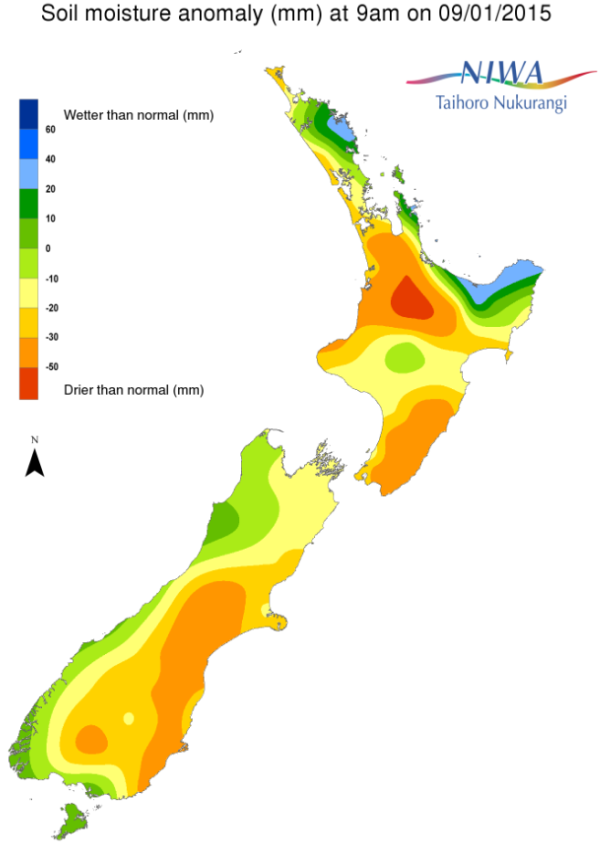Weekly update to help media assess likelihood of extremely dry weather preceding a drought. Regions experiencing severely to extremely drier than normal soils conditions are deemed “hotspots”.
Facts: Soil Moisture
For the North Island, soils continue to be much drier than normal (refer to figure below) for this time of year for the lower part of the island as well as much of the upper-central portion of the island. More specifically, from southeast Manawatu-Wanganui east and south to the Wairarapa Coast where severely to extremely dry soils for this time of the year are evident. Farther north, soils in most of the Waikato are much drier to severely drier than normal for this time of year. Drier than normal soils for this time of year are also present far southern portions of the Auckland region.
For the South Island, soil moisture levels also continue to be much drier than normal for many regions along and east of the Divide. This is particularly true for much of Canterbury and Otago where soils are severely to extremely drier than normal for this time of year. Drier than normal soils for this time of year are present in the Marlborough region.
Week-to-Week Comparison
When compared to this time last week, there has been noticeable drying of the soils over the Waikato region where there has been an expansion in terms of coverage and dryness. For the lower North Island, the area of severely to extremely drier than normal soils for this time of year has not changed significantly, with perhaps only a slight expansion evident. Canterbury, Otago and northern and north-eastern parts of the South Island all show a slight expansion of drier-than-normal soils, compared to this time last week.
Commentary
For the North Island, when considering the current soil moisture anomalies for this time of year, much of the region along and east of the Tararuas, southwest of Napier and northeast of Wellington, is a hotspot as soils in this region have been severely to extremely drier than normal for several weeks. Farther north, much of the Waikato is a hotspot area, as soil moisture continues to decrease. Southern and western parts of the Auckland region will need to be monitored for possible hotspot development over the coming days and weeks as soils there have trended drier over the past 1-2 weeks.
For the South Island, hotspots exist in much of Canterbury and Otago as the coverage and size of the hotspot area has grown. Far north and northe
ast parts of the South Island will needed to be monitored for possible hotspot development over the coming days and weeks as soils in that region have shown noticeably drying over the past 1-2 weeks.
For hotspot regions, sustained rainfall over an extended period of time is needed to return conditions back to normal. Additionally, if current conditions persist or worsen, then drought conditions may be imminent.
Background:
Hotspot Watch a weekly advisory service for New Zealand media. It provides soil moisture and precipitation measurements around the country to help assess whether extremely dry conditions are imminent.
Soil moisture deficit: the amount of water needed to bring the soil moisture content back to field capacity, which is the maximum amount of water the soil can hold.
Soil moisture anomaly: the difference between the historical normal soil moisture deficit (or surplus) for a given time of year and actual soil moisture deficits.
Definitions: “Extremely” and “severely” dry soils are based on a combination of the current soil moisture status and the difference from normal soil moisture (see soil moisture maps at https://www.niwa.co.nz/climate/nz-drought-monitor/).
Pictured below: Soil Moisture Anomaly Maps, relative to this time of year. On the left are values this time last week. On the right are the most recent values.



